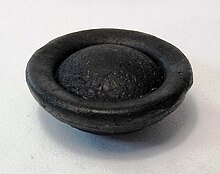
A meteorite is a rock that originated in outer space and has fallen to the surface of a planet or moon. When the original object enters the atmosphere, various factors such as friction, pressure, and chemical interactions with the atmospheric gases cause it to heat up and radiate energy. It then becomes a meteor and forms a fireball, also known as a shooting star; astronomers call the brightest examples "bolides". Once it settles on the larger body's surface, the meteor becomes a meteorite. Meteorites vary greatly in size. For geologists, a bolide is a meteorite large enough to create an impact crater.

The giant-impact hypothesis, sometimes called the Big Splash, or the Theia Impact, is an astrogeology hypothesis for the formation of the Moon first proposed in 1946 by Canadian geologist Reginald Daly. The hypothesis suggests that the Early Earth collided with a Mars-sized dwarf planet of the same orbit approximately 4.5 billion years ago in the early Hadean eon, and the ejecta of the impact event later accreted to form the Moon. The impactor planet is sometimes called Theia, named after the mythical Greek Titan who was the mother of Selene, the goddess of the Moon.

A meteoroid is a small rocky or metallic body in outer space. Meteoroids are distinguished as objects significantly smaller than asteroids, ranging in size from grains to objects up to a meter wide. Objects smaller than meteoroids are classified as micrometeoroids or space dust. Many are fragments from comets or asteroids, whereas others are collision impact debris ejected from bodies such as the Moon or Mars.

Tektites are gravel-sized bodies composed of black, green, brown or grey natural glass formed from terrestrial debris ejected during meteorite impacts. The term was coined by Austrian geologist Franz Eduard Suess (1867–1941), son of Eduard Suess. They generally range in size from millimetres to centimetres. Millimetre-scale tektites are known as microtektites.

Lake Elgygytgyn, also transcripted El'gygytgyn, is a crater lake in Anadyrsky District, Chukotka Autonomous Okrug in northeast Siberia, about 150 km (93 mi) southeast of Chaunskaya Bay.

Zhamanshin is a meteorite crater in Kazakhstan. It is 14 kilometres (8.7 mi) in diameter and the age is estimated to be 900,000 ± 100,000 years (Pleistocene). The crater is exposed at the surface.
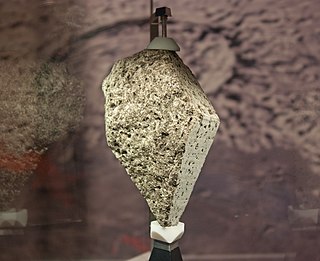
Moon rock or lunar rock is rock originating from Earth's Moon. This includes lunar material collected during the course of human exploration of the Moon, and rock that has been ejected naturally from the Moon's surface and landed on Earth as meteorites.
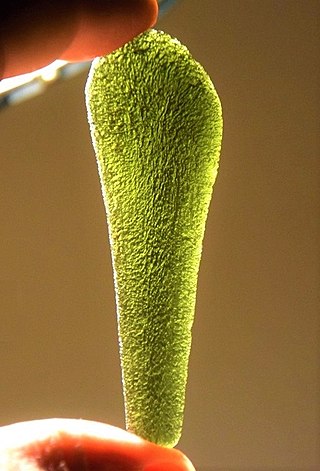
Moldavite is a forest green, olive green or blue greenish vitreous silica projectile glass formed by a meteorite impact in southern Germany that occurred about 15 million years ago. It is a type of tektite and a gemstone. Material ejected from the impact crater includes moldavite, which was strewn across parts of Germany, the Czech Republic and Austria.
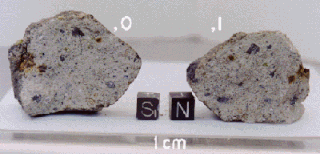
HED meteorites are a clan (subgroup) of achondrite meteorites. HED stands for "howardite–eucrite–diogenite". These achondrites came from a differentiated parent body and experienced extensive igneous processing not much different from the magmatic rocks found on Earth and for this reason they closely resemble terrestrial igneous rocks.

Libyan desert glass or Great Sand Sea glass is an impactite, made mostly of lechatelierite, found in areas in the eastern Sahara, in the deserts of eastern Libya and western Egypt. Fragments of desert glass can be found over areas of tens of square kilometers.

Bediasite is a form or type of tektite, which is a body of natural glass formed from earth debris during meteorite impact events. It originates in an area in the eastern part of the U.S. state of Texas centered on the small town of Bedias which is 74 miles (119 km) north west of Houston. They are found in about nine Texas Counties in an area of over 7,000 square miles (18,000 km2). The largest specimen ever found is just over 200 grams.

Georgiaite is a rare form of tektite found only in the state of Georgia in the southeastern United States. These tektites are found in part of the North American strewn field coming from what is believed to be the Chesapeake Bay impact crater in the late Eocene epoch over 35 million years ago. Two strewn fields and tektite groups are currently associated with this impact: the black bediasites in Texas and the green georgiaites in Georgia.

The Australasian strewnfield is the youngest and largest of the tektite strewnfields, with recent estimates suggesting it might cover 10%–30% of the Earth's surface. Research indicates that the impact forming the tektites occurred around 788,000 years ago, most likely in Southeast Asia.
Edward Ching-Te Chao was one of the founders of the field of impact metamorphism, the study of the effects of meteorite impacts on the Earth's crust.
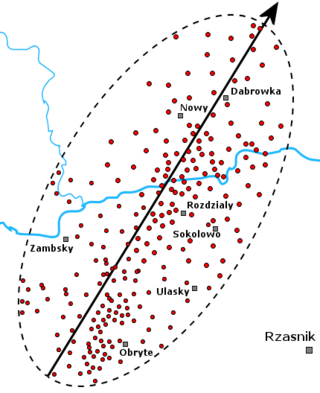
A strewn field is the area where meteorites from a single fall are dispersed. It is also often used for the area containing tektites produced by large meteorite impact.
Charles Carter Schnetzler was a planetary scientist at NASA's Goddard Space Flight Center. Schnetzler is best known for analyzing Moon rocks brought back by the Apollo program and for studying the Earth's environment using the Landsat and the Earth Observing System. Schnetzler was born in Whiting, Indiana and grew up in Neodesha, Kansas. On November 4, 2009, Schnetzler was seriously injured after being hit by a motorist while walking near his home on Little Patuxent Parkway in Columbia, Maryland. He later died in his home on December 15, 2009.
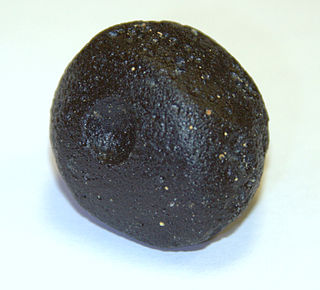
An Indochinite is a type of tektite. Tektites were ejected into the Earth's upper atmosphere by a meteorite impact and subsequently cooled to form the distinctive glass-like structure. Indochinites are distinctly dark black in contrast to the green of European moldavite tektites. It is estimated that these bodies of solidified magma are 700,000 years old. Indochinite tektites, as the name suggests, are found in the Indochinese peninsula, from Australia and the Pacific islands of Micronesia in the east and south, to China and Indonesia in the north and west. The largest indochinite is a Muong-Nong type tektite, which had a mass of 29.0 kg.
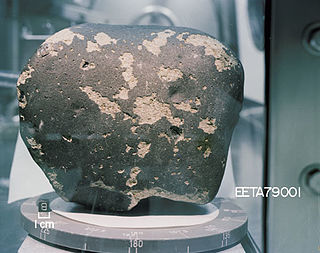
Elephant Moraine 79001, also known as EETA 79001, is a Martian meteorite. It was found in Elephant Moraine, in the Antarctic during the 1979–1980 collecting season.
Charles Albert Edward Fenner was an Australian geologist, naturalist, geographer and educator.
